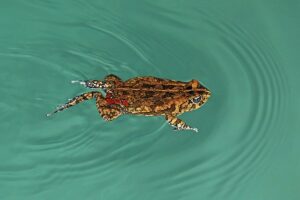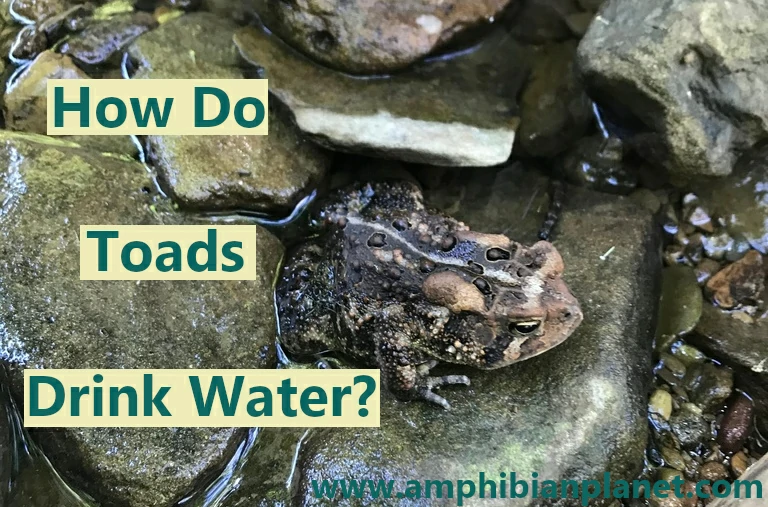All living things need water to survive. Water plays a vital role in the regulation of toads’ body fluids, and allows their bodies to keep up with important functions, such as getting rid of wastes and bringing nutrients to cells.
Toads do not drink water through their mouths like we do. Instead, they rehydrate by absorbing water across their permeable skin, in a process known as ‘cutaneous absorption’.
All true Toads in the genus Bufo have a highly vascularized area of skin located in the ventral pelvic region known as a ‘drink patch’ or seat patch – which is responsible for as much as 70 percent of their total water uptake.
Do Toads Drink Water?
Like all animals, toads need to consume water to survive. Dehydration can be harmful, and even potentially lethal to most toads. Their need for water is as critical as their need for food or oxygen–it’s an essential substance, that keeps their bodies working normally.
Toads’ bodies need a steady supply of fluids to transport nutrients, eliminate waste, and perform many other important functions.
As earlier mentioned, toads generally acquire water by absorption across their skin rather than by oral drinking.
Amphibians have unique skin compared to that of many other vertebrates. Their skin is composed of thin membranous tissue that is quite permeable to water and contains a large network of blood vessels.

This permeable skin distinguishes them from mammals, birds, or reptiles.
Permeability relates to how easily a gas or liquid molecule can pass back and forth from the environment into the animal and vice versa.
Typically, the larger the molecule, the more difficult it is to enter the animal through its skin. Amphibian skin is more permeable than that of other vertebrates.
Their membranous skin allows water and respiratory gases to readily diffuse directly down their gradients between the blood vessels and the surroundings.
Many toads are even known to rehydrate by absorbing moisture from moist soil, through their skin.
How Do Frogs Drink Water?
Although most of a toad’s skin is permeable to water, all toads in the genus Bufo have a highly vascularized area of skin on their belly and the underside of their thighs (the ventral pelvic region), known as the ‘drink patch’, ‘drinking patch’, or the ‘seat patch’. This area of skin is responsible for most of their water uptake.
The drink patch has a very large network of small blood vessels called capillaries. Water absorption across this skin is driven by the osmotic gradient that develops as a consequence of solute transport.
In simple words, the skin acts in concert with the kidney and urinary bladder to maintain fluid balance
During periods of rehydration, toads adopt a posture known as “water absorption response” (WR) – in which they thrust their hindlimbs backward and press the belly surface onto any surface containing water.
Even though the drink patch skin only constitutes about ten percent of the total skin area, it is responsible for over 70 percent of the total water uptake by many dehydrated toads.
Do Toads Feel Thirsty?
In mammals, thirst motivates water seeking and consumption. It involves the stimulation of the thirst center in the hypothalamus as a result of a decrease in the volume of the extracellular fluids.
Some amphibians appear to seek water in which to lie in order to rehydrate.
This has led some researchers to suggest that this process may constitute a ‘primeval thirst’, which is quenched by the absorption of water across the skin, instead of by oral drinking.
What Sources Do Toads Use to Rehydrate?
Toads can rehydrate by absorbing water from direct water sources, as well as indirect water sources.
1. Direct Water Sources
Although toads are generally not as strong of swimmers as aquatic frogs are, all toads can swim.
Toads often seek out shallow bodies of fresh water in which they can soak and lie – to rehydrate.

In rainy weather, it’s common for toads to come of out their retreats, and soak in rain puddles on the ground. While they soak in water, they absorb some of the water through their skin and rehydrate.
Many toads also rehydrate by absorbing dew droplets condensed on grass or other surfaces.
2. Indirect Water Sources
Apart from using direct water sources, toads also rehydrate by absorbing moisture from moist soil, or any other moist material, such as damp leaf litter.
Toads can absorb moisture through their skin even when they are underground. This is especially useful because they spend a lot of their time tunneled under the soil to escape the drying heat of the sun.
Toads that live in very humid environments can also hydrate by absorbing the moisture in the air as it condenses on their skin. This is especially true at night when the temperatures are cooler.
Below is a table that shows the water sources that toads use to rehydrate:
Direct Water Sources |
Indirect Water Sources |
| Woodland ponds | Moist soil |
| Temporary rain puddles | Moist leaf litter |
| Flooded ditches | Condensed dew droplets |
| Bogs, Marshes, Swamps, etc | Atmospheric humidity |
| Other shallow water bodies such as lake edges |
Toads Occasionally Swallow Small Quantities of Water
Although frogs and toads generally do not orally drink water to rehydrate, many frogs and toads are known to occasionally swallow small quantities of water. This can happen when they submerge their heads in water.
In one study, northern leopard frogs (Lithobates pipiens) were dehydrated until they had lost water equivalent to about 30% of their body weight.
When placed in tap water, the frogs rapidly regained this lost water, and 1·4% of the total water uptake was taken up by drinking.
In the same study, African clawed frogs (Xenopus laevis), were also dehydrated until they lost water equivalent to about 26% of their body weight.
When placed in fresh water, they regained their lost weight very slowly and after 2 hours in tap water, had only reaccumulated one-fifth of the water which they lost – with drinking making up 8% of the total water uptake.
According to the same study, this drinking was not in response to dehydration (primary drinking), but appeared to constitute ‘secondary’ drinking, which was not directly related to osmotic need.
Little scientific research has been done on this topic, and it’s not clear why some frogs and toads occasionally orally drink small quantities of fluid.
More About Toads And Water
Toads generally live a highly terrestrial life and are not as dependent on water as most other frogs are. However, like all animals, toads still need to consume water to survive.
Toads do not ‘drink’ water as we do. Instead, they consume water by absorbing it through their permeable skin.
Toads in wet environments may sit and soak in shallow water to rehydrate, but others may rehydrate by absorbing moisture from moist soil, damp leaf litter, or other moist substrates.
Learn more about toads and water by reading these articles:
Sources:
J. Bentley, T. Yorio; Do Frogs Drink? J Exp Biol1 April 1979; 79 (1): 41–46. doi: https://doi.org/10.1242/jeb.79.1.41
Fitzsimons, J.T. (1975). Thirst and Sodium Appetite in the Regulation of the Body Fluids.In: Peters, G., Fitzsimons, J.T., Peters-Haefeli, L. (eds) Control Mechanisms of Drinking. Springer, Berlin, Heidelberg. https://doi.org/10.1007/978-3-642-61907-6_1
P.J. Bentley, K. Schmidt-Nielsen, Acute effects of sea water on frogs (Rana pipiens), Comparative Biochemistry and Physiology Part A: Physiology, Volume 40, Issue 2, 1971, Pages 547-548, ISSN 0300-9629, https://doi.org/10.1016/0300-9629(71)90047-8.
Katz; NaCl adaptation in Rana ridibunda and a comparison with the euryhaline toad Bufo viridis. J Exp Biol1 December 1975; 63 (3): 763–773. doi: https://doi.org/10.1242/jeb.63.3.763
Malcolm S. Gordon, Vance A. Tucker; Osmotic Regulation in the Tadpoles of the Crab-Eating Frog (Rana Cancrivora). J Exp Biol 1 June 1965; 42 (3): 437–445. doi: https://doi.org/10.1242/jeb.42.3.437
Condensation onto the Skin as a Means for Water Gain by Tree Frogs in Tropical Australia. Christopher R. Tracy, Nathalie Laurence, and Keith A. Christian
The American Naturalist 2011 178:4, 553-558


